Tag: Cab Franc
Outsmarting Birds and other Vineyard Predators
The grapes at DuCard Vineyards are starting to ripen nicely, which means that pretty much every creature that walks, flies or crawls is out to feast on them.
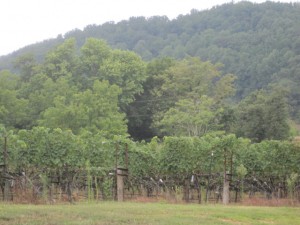
DuCard Vineyards in mid-August. The Cab Franc grapes are looking beautiful. Should be another great vintage for DuCard
There’s an old saying that goes something like this: when the deer begin eating the grapes, the Brix (a measure of the sugar level) is 20, when the birds begin feeding, it’s 22, and when the bees go after grapes, it’s time to harvest. (If anyone has a more accurate take on that little bit of country wisdom, please post a comment!)
That aphorism probably ascribes a level of precision to nature that can’t be verified with scientific instruments, but it does give you an idea of what the grape farmer is up against. After a growing season in which the vines are threatened by any one of a dozen pests or diseases, not to mention the vagaries of weather, Mother Nature presents a whole new set of challenges just as the grapes are reaching perfection.
Saturday’s vineyard management class at DuCard focused on a number of these problems, and some of the tried and true solutions that have been used by viticulturists for years. Some are high tech, like the box that transmits sounds of birds in distress throughout the vineyard, and others are decidedly low-tech: balloons and CDs hanging from trellises in spots where they’ll catch a bit of sunlight. All three seem to work pretty well.
Birds apparently have some early warning systems. They understand the vineyard is supposed to look a certain way, and when they see something out of the ordinary, they look for safer pastures, so to speak. The CDs catch a glint of sunlight, and are visible to the birds as they approach, sending off the signal
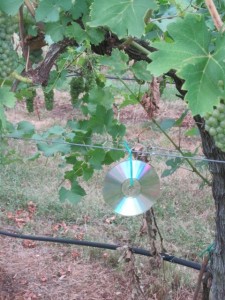
Any old song will do: Not sure if it matters which CDs we hang from the vines, they all seem to scare the birds.
that something is not quite right here, so move on, and be quick about it. The balloons accomplish the same thing. In other vineyards, I’ve seen foil streamers flying in the breeze, which has the same effect.
And the deer will be coming soon as well. DuCard is located in the midst of open country, some of the most beautiful country you’ll ever see, and so it’s home to more deer than any of us can count. The electric fence is going up this week, and between the fence, the balloons and the CDs, Scott thinks he has “about a 95 percent solution,” which I think is a nice compromise with nature.
While walking through the vineyard Saturday, I tasted a few Cab Franc and Viognier grapes, and was impressed by the sweetness. We’re getting toward the end of the period of veraison, the time in which the berries stop growing in size and begin ripening, turning color in the process. The Cab Franc gapes, for example, were about 80 percent there (by my own seat-of-the-pants measurement), with most of the grapes blue-black in color, and only a few still greenish. They’re looking magnificent, and the growing sugar level was evident on my tongue when I tasted the grapes.
As we move toward harvest, the sugar will continue to increase and acidity will drop. The seeds inside the grape will turn color from their current green to more of a brown, and will lose their bitterness. Soon, Scott Elliff, DuCard’s owner, and Julien Durantie, his vineyard manager, will begin testing the grapes regularly, taking advantage of both technology (checking the Brix with a refractometer), and the knowledge that comes from years of working in vineyards (looking at the seeds, chewing the skin to get an idea of the tannins, etc.)
The day of the harvest can’t be predicted this far in advance, and of course each of the four varieties of grapes Scott grows will ripen at different times. But at some point for each, everything will come together, and Scott will make the judgment that it’s time to get the grapes off the vine and onto the crush pad.
And then we can start dreaming about the wine.
Meet the Vines: Fairfax — The Magnificent Seven
Well, I thought it was time to start introducing everyone to the vines I’ve planted, starting with the Fairfax vineyard. As I’ve said in the past, seven vines hardly constitutes a vineyard, and yet it’s big enough to yield enough grapes for five gallons of wine — about 30 bottles — when I get my first real harvest in three or four years. Not too shabby.
The vines in Fairfax are growing like Topsy, and I wonder sometimes if there’s too much vigor in this vineyard. Vines themselves are capable of amazing growth. They can grow higher than the trees in our yard, and we have really tall trees. But that’s not what we’re looking for. In these first few years, we want to funnel the energy of the vine into the development of the root system, and after that, into the grapes themselves. What we don’t want is for the vine itself to grow out of control, stealing vigor from the roots in the first years and the grapes thereafter.
The rootstock on these vines is of a type known as 101-14, which is a low vigor rootstock. And basically, I think we’re doing okay. We’ll see. But for now, let me introduce you to the Magnificent 7 (and believe me, they are magnificent!), one vine at a time. FYI, they are all Cab Franc.
First, here’s the back row, closest to the backyard fence (you can see a patch of Day Lilies, with a few unpulled weeds, on the other side of the fence). This row also has a rose bush between the two vines.
And here’s the middle row. The vines are all tied to faux bamboo poles. The large stake next to them is a leftover from the initial planting, before I had a fence up and was worried that the lawn service might mow them down without a few obstacles.
Finally, the third row, three vines strong. The middle vine is the giant of the group, nearly five feet tall, and the last is the runt of the litter. But I have every confidence that the little guy will produce great wine grapes someday, maybe the best in the vineyard.
So there it is. The vineyard ain’t huge, but it has loads of personality! And here’s a couple of shots that illustrate the humble beginnings of this patch of vines.
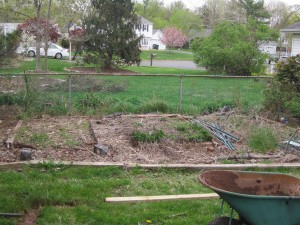
And here's a wider shot. Note the wheelbarrow in the foreground, a sure sign that I'm about to get my hands dirty.
The Potato Leafhopper Saga, Part II
Continuing the Potato Leaf Hopper saga, which strictly speaking hasn’t yet risen to the level of a saga, it looks like we’re making some progress. We evaluated our Nelson County vines over the weekend and are reasonably happy with what we saw. The new leaves looked healthy and disease free, and the vine seems to be growing nicely (well, with the exception of one vine, which appears to be the runt of the litter).
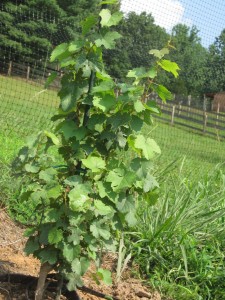
- This Cab Franc vine is growing slowly, but it appears healthy. No holes in the leaves from Leafhoppers, and good color.
Most important, the Potato Leafhoppers appear to have all but vanished. Two weekends ago, they were gone. Last weekend, we found one or two, and removed them by hand. We’ll check again next weekend, but for now, the Vineyard Goddess is resting easy, and we doubt we’ll need to hit the vines with another dose of pesticide.
Now, I’m sure some of you are wondering if I was being a bit overly dramatic. You’re thinking, yeah, the Potato Leafhopper is probably some kind of mean little insect, Bob, but in a world full of pests, it’s pretty small fry. It’s not like Donald Trump parked himself in your vineyard and let the property go to seed. (Actually, that would be the vineyard some 30 minutes down the road.)
But trust me, the Potato Leafhopper is a pest to be taken seriously. Consider this statement from the Compendium of Grape Diseases, an authoritative guide to vineyard problems: “Few insects have plagued grape growers during the last century more than leafhoppers.”
According to the Compendium, the potato leafhopper breeds in the Gulf Coast states over the winter, then grow in number through March and April before migrating northward, distributing themselves over most of the U.S. The leafhopper harms grapes “by mechanically injuring and blocking vascular tissue, by injecting toxic enzymatic secretions, or by a combination of both mechanisms.” You ever see Trump blocking any vascular tissue?
In any event, it appeared that the Leafhopper was doing considerable damage to the vineyard, and we were ready to go to war with it. With luck, we might have put that pest behind us, which will free us up to deal with the myriad other problems that plague vineyards. Like overly acidic soil. Or Downey Mildew. And someday, maybe, birds, foxes and bees. Stay tuned for the next report from the front.
A Tale of Two Vineyards, Part I (In which the origin of the Fairfax vineyard is described.)
The decision to plant vines this year came after a lot of hand-wringing and was made only at the last minute. Looking back, it's hard for me to believe that we agonized so long over this decision. After all, we planted a grand total of 14 vines on two properties, not exactly a huge commitment of time or money. And now that we've worked a bit with them, most of
Digging out the old vegetable garden to make room for vines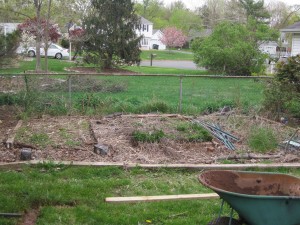
the concerns I had have long since faded away.
At the time, though, I wondered how we would find time to care for them. How we would manage the spray schedules. How we would get the soil ready. And how we would manage the trellising on such short notice.
We ended up planting two vines in Nelson County that were given to us after a class on vine grafting, and once we had those in the ground, we realized this was something we could do. So, I took a leap of faith and ordered a dozen Cab Franc vines from Double A Vineyards, figuring that by the time they arrived, we'd find a way to get the ground ready for planting at both the Fairfax and Nelson County sites. More on the Nelson County vineyard later.
The first pictures show the state of play in the Fairfax vineyard at the time I ordered the vines. It's part of an old garden, plus a bit of lawn that I decided to appropriate in order to provide room for three separate rows.
A closer look at the future Fairfax Vineyard - not a pretty sight, and not much time to prepare.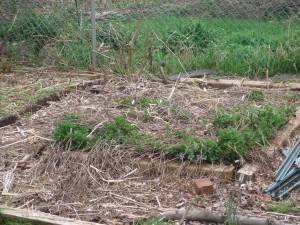
We're not talking big rows: two, with two vines each, and a third with three vines. But it's enough to provide grapes for five gallons of wine, just the right amount to ferment at home.
My first problem was finding the time to prepare the vineyard. We were going out of town most weekends (hanging out at the site of the Nelson County family vineyard), and it was getting dark early. Working when I could, I found time to clear out the growth in the garden, clear the sod in the lawn, and lay out the rows, using eight-foot metal fence posts as a guide. The rows were laid out seven feet apart, and the vines were to be spaced six feet apart.
The vines arrived on April 20, and I realized we would not have time to plant in Fairfax that week. Inside the packaging, the roots were wrapped with shredded newsprint that was still soaking wet. It was probably enough moisture, but I added a bit more water anyhow, and resealed the package. Anything worth doing is worth overdoing, in my humble opinion.
Overdone or not, the vines stayed healthy, and I planted the following week on April 26. Vines may be a bit too big of a word to describe what we actually planted. The plants consisted of a healthy-looking root (101-14 for those of you who care about such things – and if you are interested in establishing your own vineyard, you must care about such things), that ended with the graft union. What I was more familiar with was a plant that had both root and a scion, which is the particular type of vine. Cab Franc, for example, comes in a number of different clones and, again, for those of you who care about such things, these were FPS 04/332, grafted onto the 101-14 rootstock. Except that I couldn't see any part of the scion. In other words — and to get back on point — I was accustomed to seeing vines that looked like vines, not roots with a tiny stub of a graft union on top.
I called the nursery, and was told that the graft union had tremendous growth potential that would be unleashed if I simply hilled it over (covered it with dirt) and waited for the shoots to break through. I felt a bit like Jack and the Beanstalk being told to bury magic beans, but I did it anyhow, and three weeks later I had a bit of growth beneath the hilled-over soil. (It went a bit faster in Nelson County.)
In the foreground, a Cab Franc vine stands 25 inches tall. The one in the background a bit smaller.
We carefully cleared the hilled-over dirt away, making sure that the graft union was at least two inches above ground. The concern is that if the soil manages to come into contact with the scion above the graft union, the vine itself will begin to develop roots and will essentially be growing on its own root. This is a story for another time, but to make it quick, the vine has everything it needs to grow, including the ability to develop roots, but lacks one thing — resistance to Phylloxera, an insect that that nearly destroyed Europe's vineyards in the 19th century. That's why Vinifera vines (Merlot, Cab, Chard, pretty much every varietal you're accustomed to drinking) must be grafted onto American root stock, which is mostly immune to Phylloxera.
We let these vines grow without the grow tubes we used in the Nelson Vineyard. We worried about that decision for a long time (well, weeks) until we decided that grow tubes were creating more problems than they were solving.
In any event, these vines are doing pretty well.
They seem healthy and vigorous (hopefully not too vigorous), and the tallest of the group is about 25 inches. They need to be pruned back, but that's a story for next time. I've included three pictures, including one with Phoenix the Vineyard Dog standing guard from outside the fence.
One footnote: the fence serves to keep Phoenix out, but won't help with rabbits, deer or any of the other Bambi/Thumper-type predators that feed on vines. Very soon, we'll be putting up a deer fence, but for now we're counting on luck to keep these young vines safe.
Phoenix the Vineyard Dog standing guard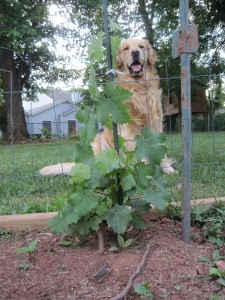
Goodbye to Grow Tubes Forever!
Apparently there’s no agreed-upon rule book for viticulture.
When we planted Cab Franc vines on our Nelson County property, we followed the advice offered at a class on that very subject at the Piedmont Virginia Community College (great curriculum –the best available in Virginia today), and covered them with grow tubes. We
did the same for the two Mammolo Tuscano vines which we had received as a gift from Gabriele Rausse, one of the founding fathers of the Virginia wine industry and the instructor for a class on grafting.
At another class over the weekend, we were told, in no uncertain terms, to take them off. Sigh.
After doing a lot of overnight research, we decided that the grow tubes – ours are the so-called “Blue X,” which consist of a blue plastic insert and a soft-skin translucent blue sleeve – had to go. But it was kind of a close call.
A lot of the research we looked at suggested that while grow tubes provide a hot-house environment that jump starts the growth of the vines in their early months, they also prevent the vines from achieving their potential. The focus of the first two years is developing a strong trunk and root system. As Julien, the vineyard manager at DuCard Vineyards, told me, you must be willing to do the work, and to do it when it needs to be done. And you must be willing to be patient. The tubes, he added, rushed the process and created a hot-house that could cook the vines to death in the 90-plus degree weather we’ve been having.
My wife, the Vineyard Goddess (and future Vineyard Manager), took Julien’s words to heart and found a good deal of evidence to support the anti-grow tube proposition. Continue Reading–>
A Trio of Virginia Wineries
I'm planning to add some reviews of the wineries I like, but that will take a bit more time than I have today. So, for now, I'm just going to offer a list of three wineries in the Monticello AVA that I am particularly fond of. And there is a theme here: these are the three wineries who came together to make a wine they named (appropriately enough) "3."
Emily Pelton of Veritas Vineyards stands behind bottles of "3" wine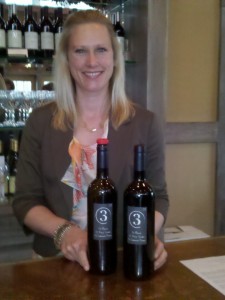
Each of the three contributed one of the varietals to the blend. Pollak Vineyards provided the Petit Verdot, Veritas Vineyard and Winery supplied the Cab Franc, and King Family Vineyards contributed the Merlot grapes. In theory, they planned to blend one third each of the grapes, but in practice, I think they realized that a blend required some judgment, and would likely end up being something other than one-third each. When blending wines, as I learned from King Family winemaker Matthieu Finot, you spend a lot of time experimenting and tasting. In this particular blend, I'm guessing that the Petit Verdot was very powerful, and they may have decided to use less of it and more of either of the other two grapes.
No matter. The wine was fabulous, and since they only made 150 cases, it sold out quickly. Each customer at Veritas was limited to three bottles at $33.33 each — yes, they carried the 3 theme pretty far — and I personally think this one will age quite well. So my three bottles are stored in my EuroCave wine celler, waiting for that perfect moment in the near future when they will achieve perfection.
The Vines Emerge into the Sunlight!
- After two weeks, this Cab Franc vine emerges from the earth
- Three Cab Franc in the foreground, two Mammolo in the background
At long last — actually, it was only two weeks — the Cab Franc vines emerged from the soil. When we planted the vines, the graft union — the large swollen area where the root stock and the scion met — was hilled over, which is to say, we made a mound of dirt to cover the graft union. The graft union very quickly sent shoots up, and so this weekend, we removed the dirt that we had mounded over the vine, sprayed for all the diseases that Virginia humidity and (especially) rain can bring, and then place the blue-x grow tubes over the vines.
In this gallery, you see on the ends (I was having a problem with the software, and it was just easier to keep two of the same picture on the ends) a picture of three of the five Cab Franc vines, plus two of the Mammolo Tuscano that we planted earlier, the Mammolos being a gift from Gabrielle Rausse, one of Virginia’s great winemakers. In the middle, is a picture of the vine that emerged from the graft union that was still buried.
As Gabrielle said to us in a class, “the vine is so smart.” It definitely knows what to do. A small cutting from the vine can be made to both bud at one end — giving rise to a vine that will bear fruit — and take root at the other. Unfortunately, Vitis Vinifera vines from Europe cannnot grow on their own roots here in the U.S. They will die from Phylloxera (which nearly destroyed the entire wine industry in Europe in the 19th century) or some other North American disease. To survive, the Vinifera vine must be grafted onto American rootstock. The rootstock my vines are grafted onto is known as 101-14.
With luck, we’ll be making wine from these vines in three short years!
Bob
Planting Vine Number 14
On Sunday, Chris and I planted the last of the dozen Cab Franc vines we had ordered from Double A Nurseries in New York. These vines were a little different from what I had expected, based on the two Mammolo vines that we had received as a gift after a class on grafting. The Mammolos had a large and beautifully blooming scion (which is the actual vine) that had been grafted to phylloxera resistant rootstock. We pruned back the scions to three buds, and planted them. Continue Reading–>

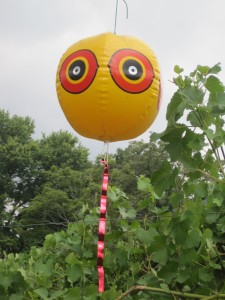
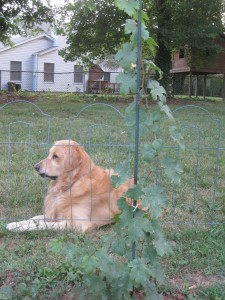
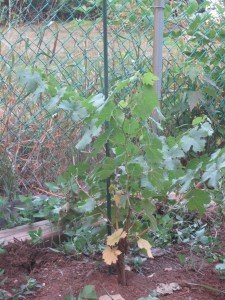
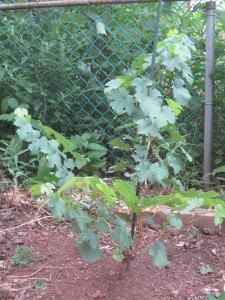
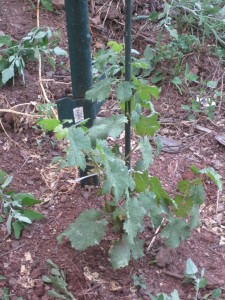
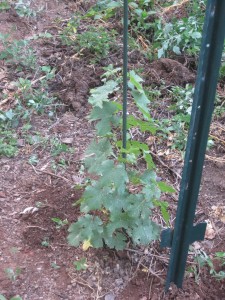
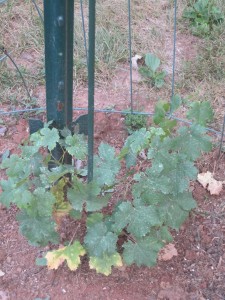
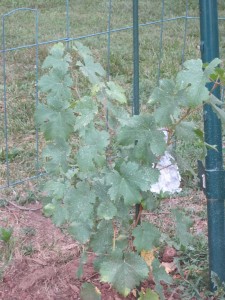

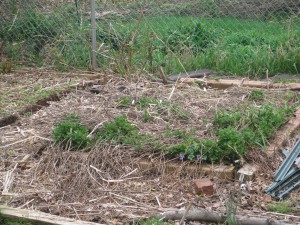
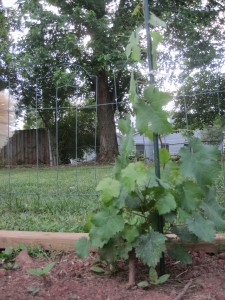
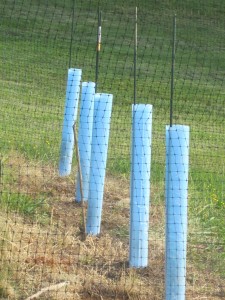
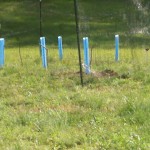
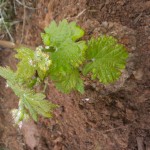
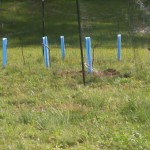


Recent Comments